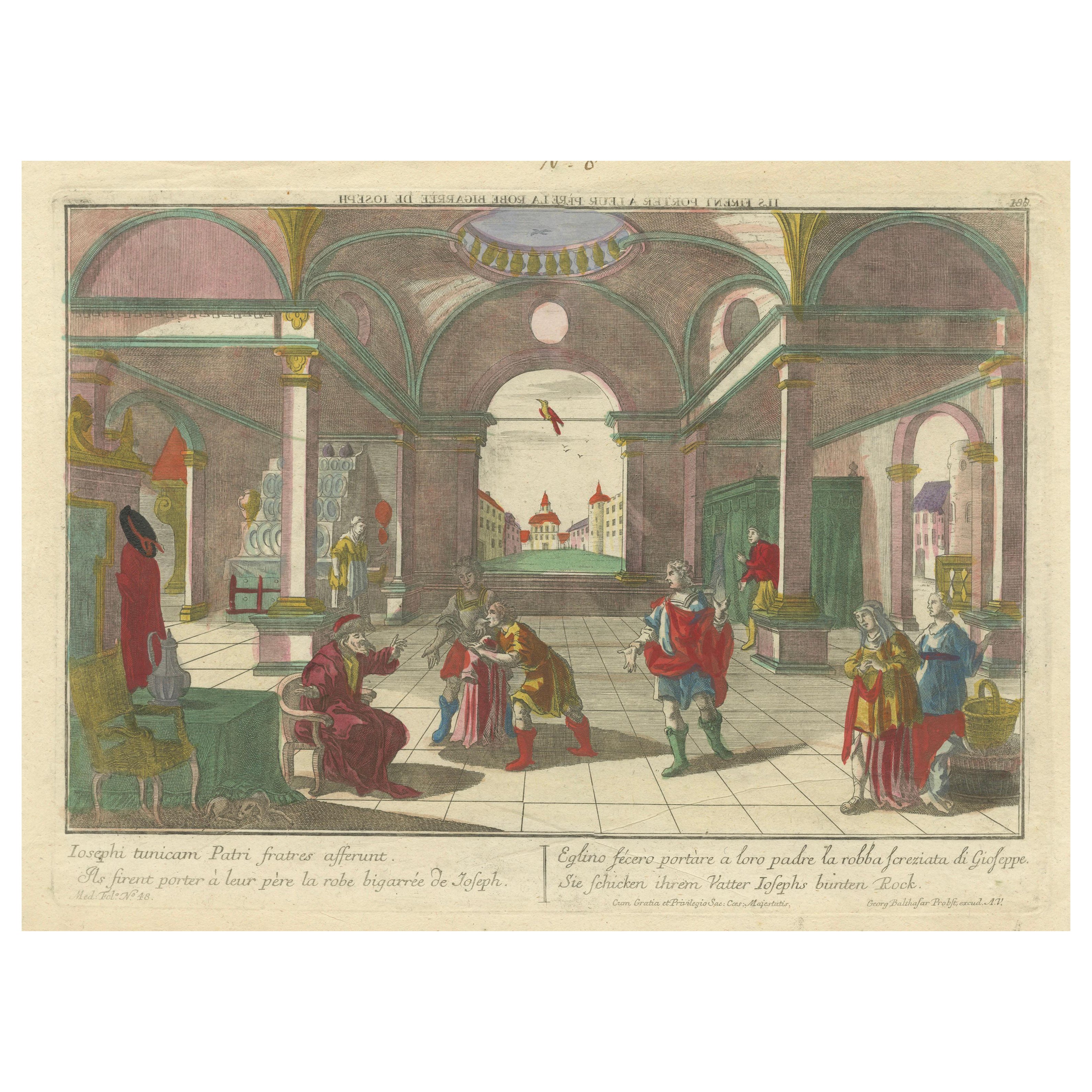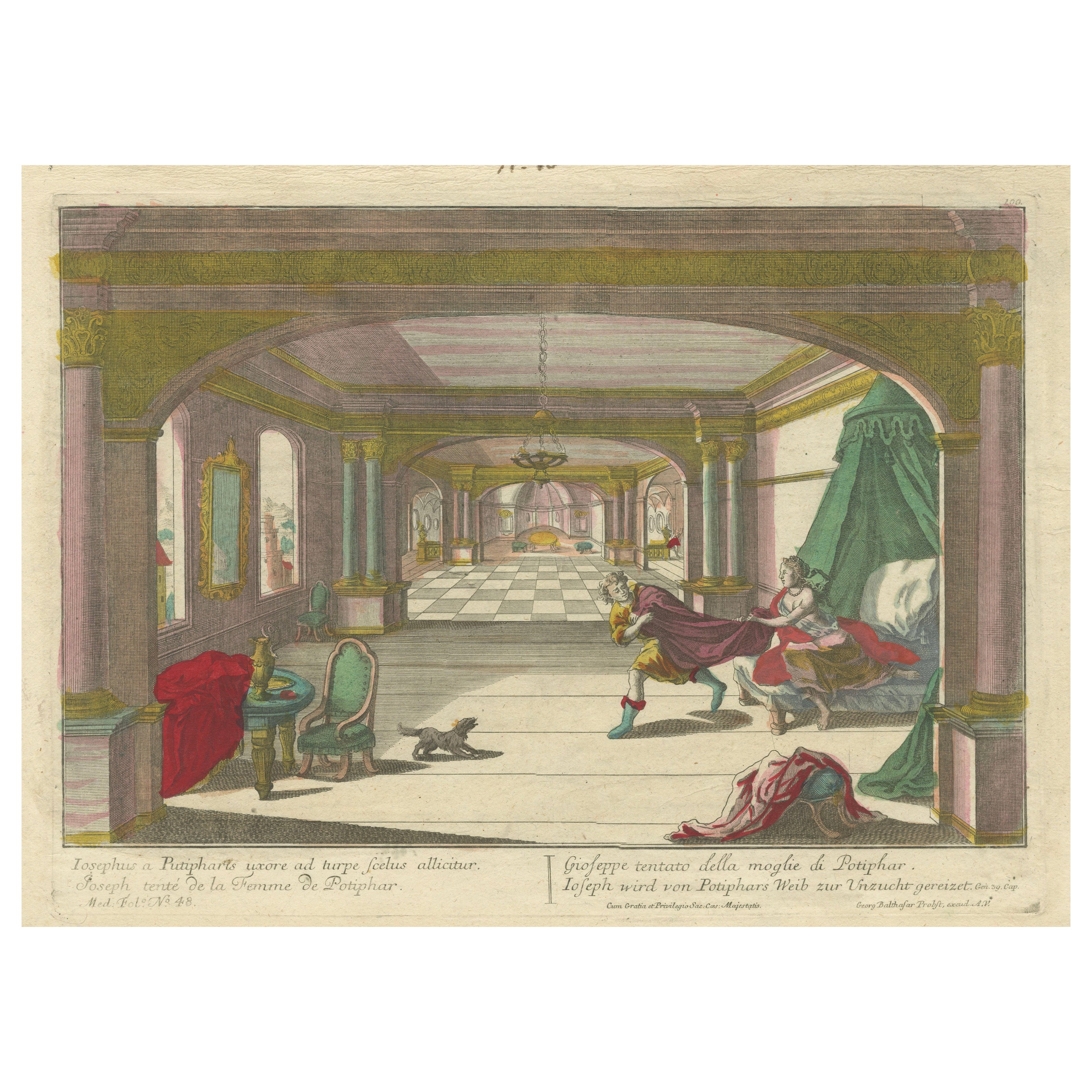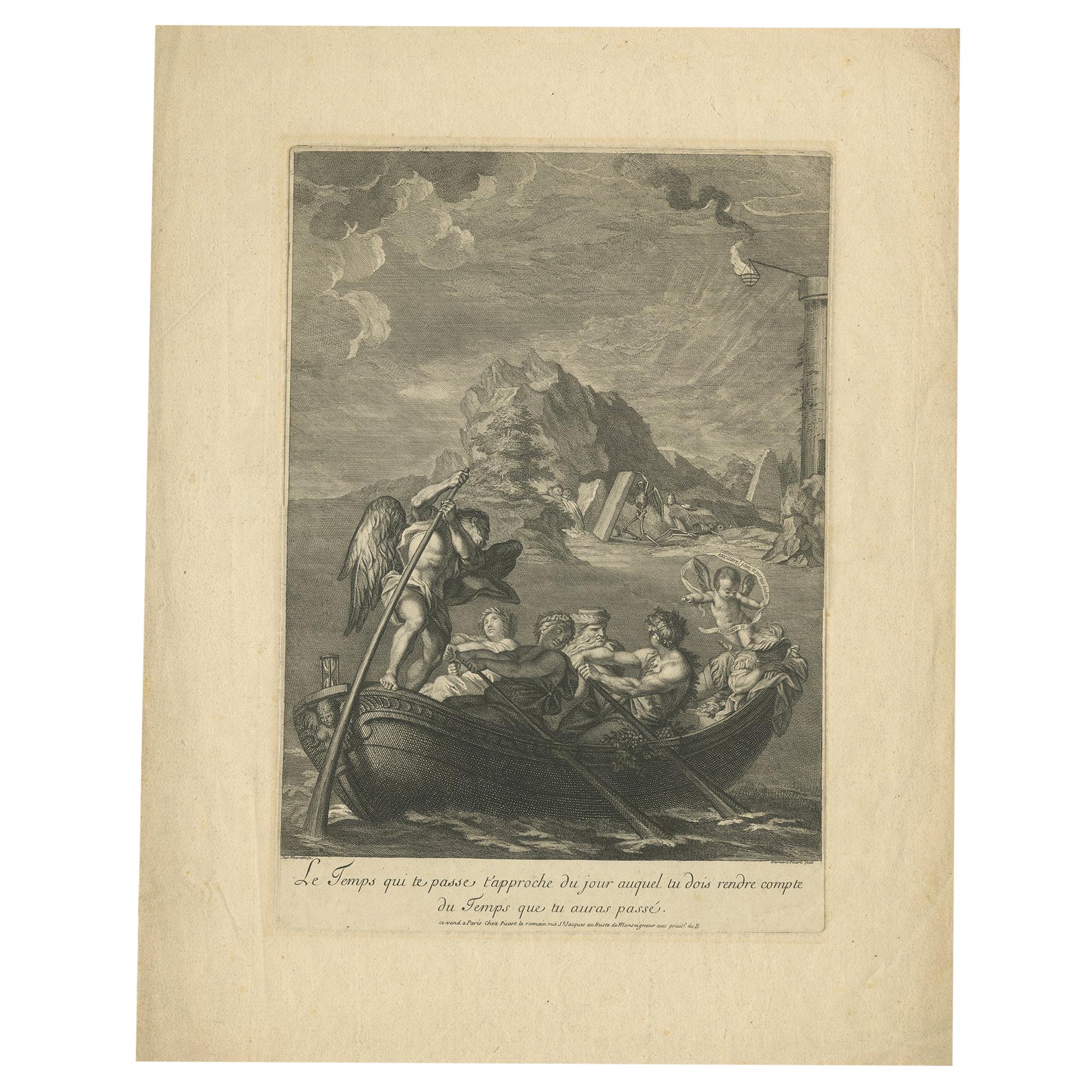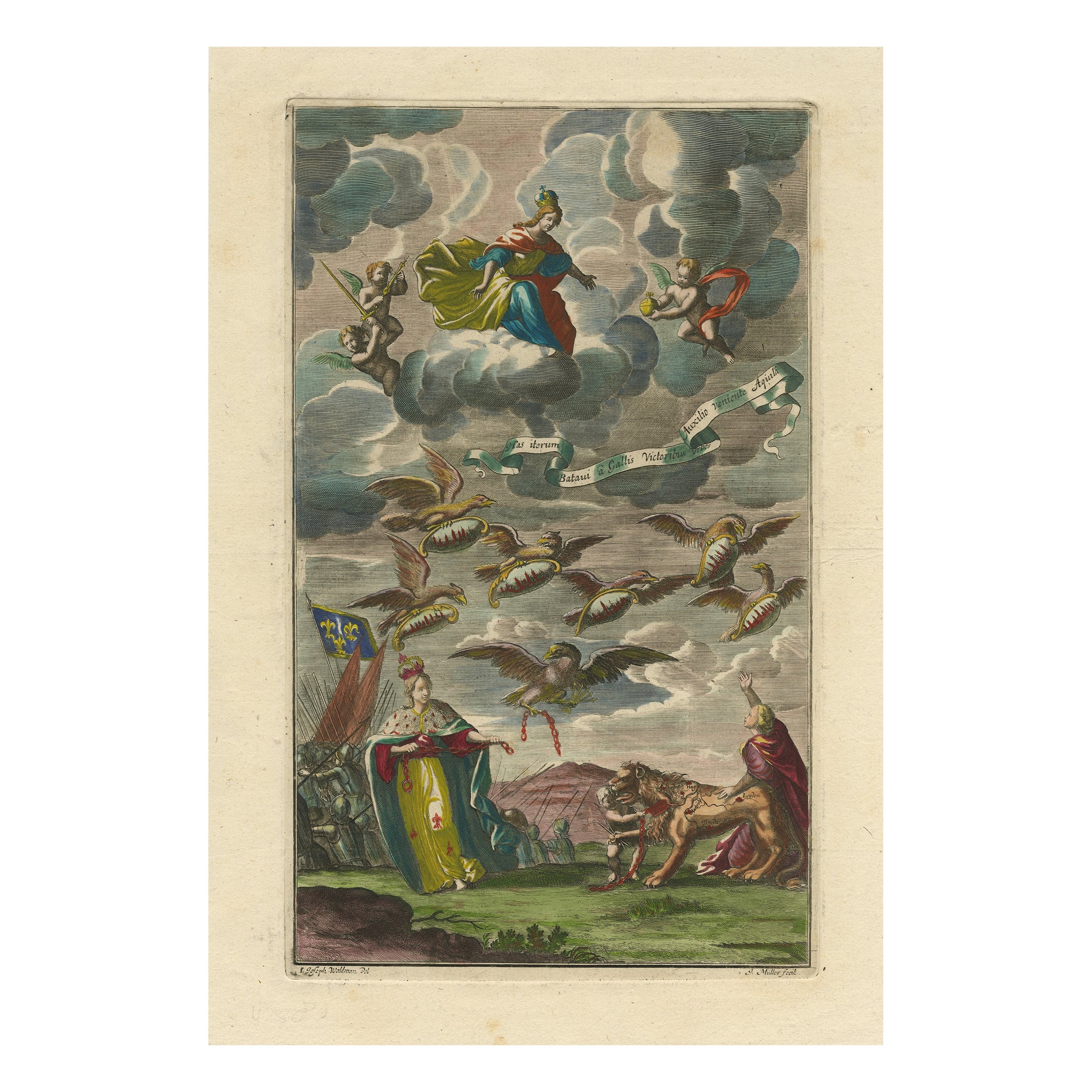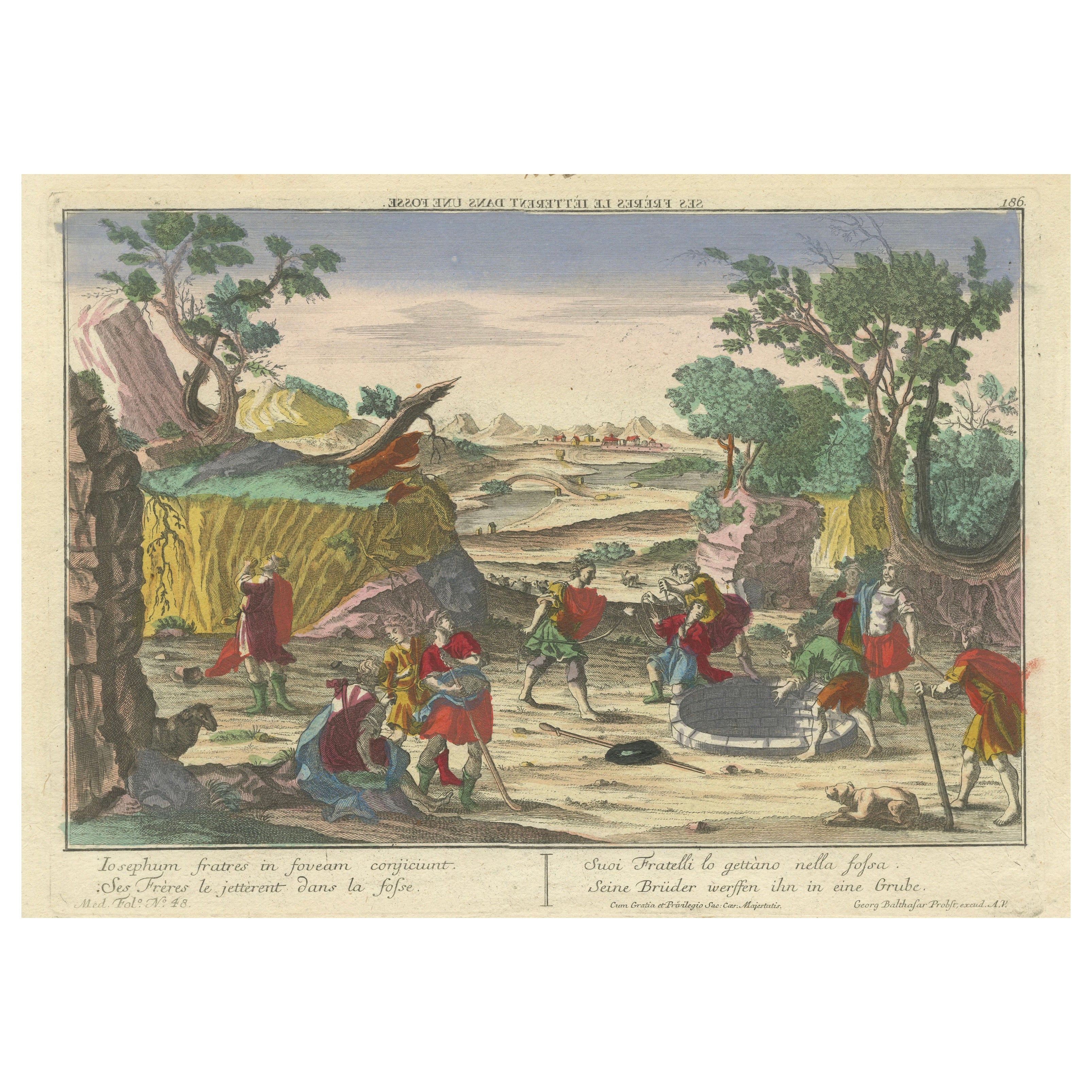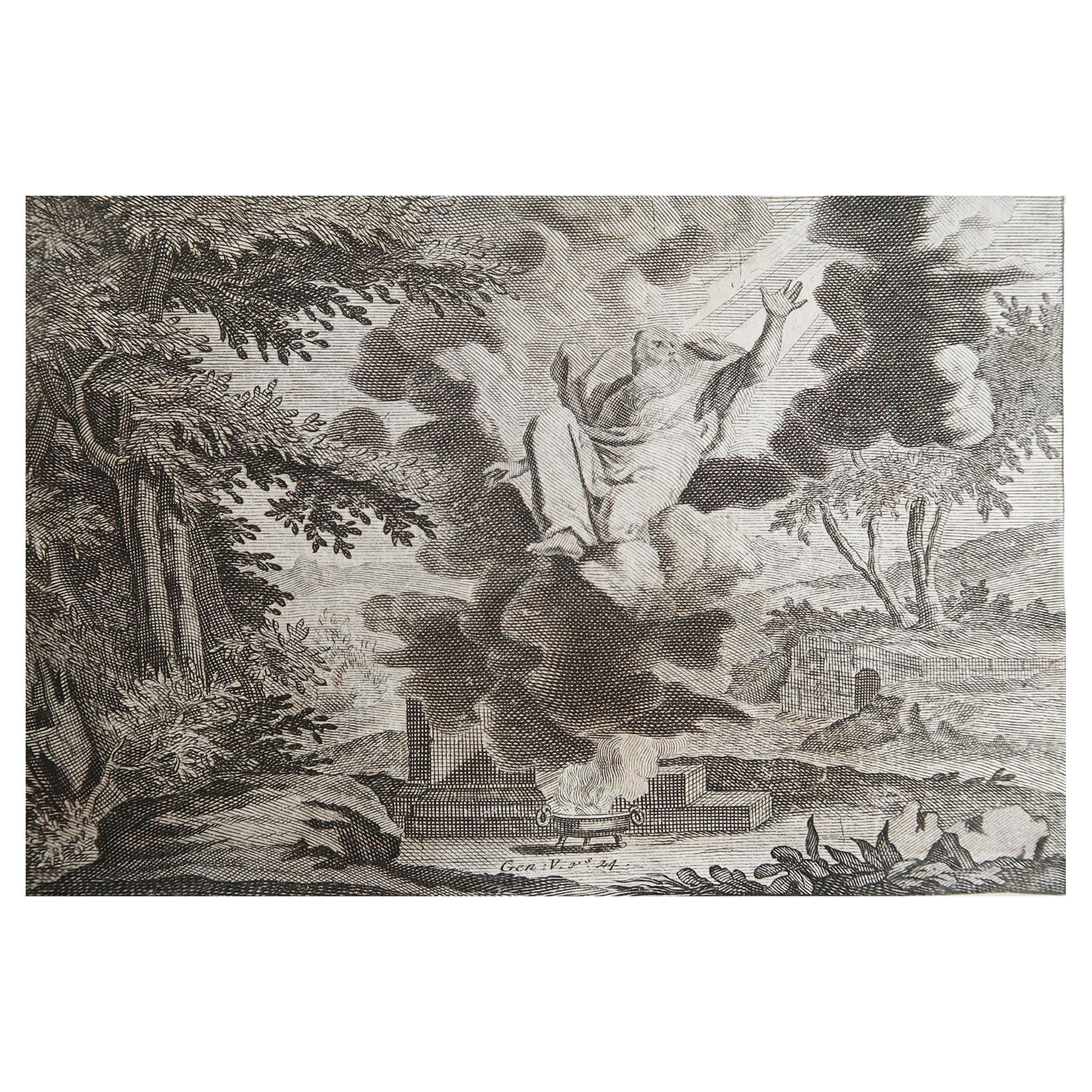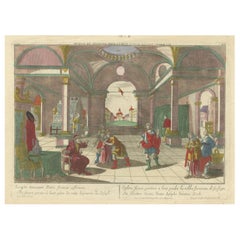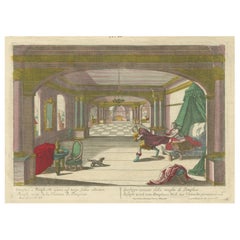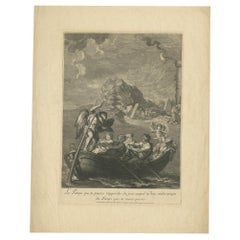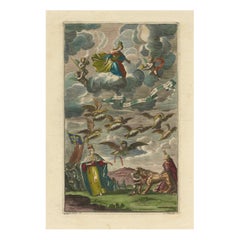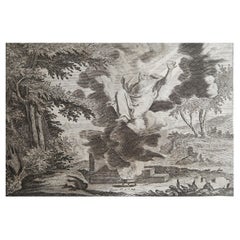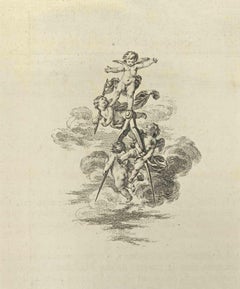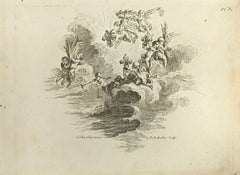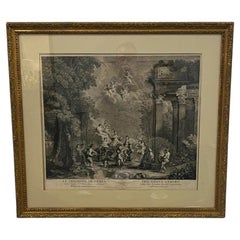Artículos similares a Optical Print of Aeolus, God of Winds – Allegory of Air, circa 1760
Cargando vídeo
¿Quieres más imágenes o vídeos?
Solicita imágenes o vídeos adicionales al vendedor
1 de 11
Optical Print of Aeolus, God of Winds – Allegory of Air, circa 1760
390 €IVA incluido
Acerca del artículo
Allegory of the Air – 18th Century Optical Print after Burnacini
This vibrant and theatrical 18th-century optical print presents an allegorical representation of 'Air', rendered with striking hand-coloring to enhance its depth and visual impact when viewed through an optical viewing box.
Engraved by Tobias Lobeck and based on a design by Lodovico Ottavio Burnacini (1636–1707), a renowned Italian stage designer, the print is a captivating synthesis of classical mythology and baroque scenography.
The composition shows a dramatic grotto interior, with richly colored rocky walls curving upward in a dome-like formation. At the center sits a regal figure—Aeolus, the god of the winds—enthroned and commanding the scene. Flanking him are winged wind spirits energetically exhaling gusts of air, their motion frozen in dynamic postures. Hovering above the entire spectacle is a female figure draped in vibrant garments, standing upon a swirling cloud. This theatrical vision echoes Burnacini’s background in stage and set design, where the blending of allegory, movement, and color was key to the baroque spectacle.
The print bears the title in four languages—German (Die Luft), Latin (Aer), French (L’Air), and Italian (L’Aria)—followed by a verse referencing Book I of Virgil’s *Aeneid*, where Juno appeals to Aeolus to release the winds in order to punish the Trojans. This cross-lingual and literary framing underscores the print’s Enlightenment-era role in both education and entertainment.
The publication line identifies Tobias Lobeck as engraver, and credits Burnacini as designer. The print was issued with the privilege of the Holy Roman Emperor by the Imperial Academy in Augsburg (Negotium Academiae Caes. Francisceae excudit Aug. Vind.), a key center for such optical and theatrical prints in the 1700s.
Condition summary:
Well-preserved with bright original hand-coloring. Minor toning to the margins and faint signs of handling, but no major flaws. Rich detail remains intact and colors are striking. Small remains of tape on the borders of the reverse. Patina rich optica print.
Framing tips:
Frame with a gold or black moulding and a soft cream mat to emphasize the vivid colors. Use museum glass to preserve detail and reduce glare. Ideal for a library, hallway, or collector’s wall of curiosities.
This optical print was published in the 18th century, most likely between 1740 and 1780, when Tobias Lobeck was active in Augsburg. While no exact year is printed on the sheet, it was issued by the Imperial Franciscan Academy (Academiae Caes. Francisceae) with imperial privilege, placing it firmly within that mid-18th-century context.
Tobias Lobeck’s collaboration with designs by Lodovico Ottavio Burnacini, who died in 1707, also supports this dating, as Burnacini’s theatrical designs were frequently adapted and engraved posthumously in the mid-1700s for optical prints and stage scenes popular throughout Europe.
- Dimensiones:Altura: 30,3 cm (11,93 in)Anchura: 43,5 cm (17,13 in)Profundidad: 0,2 mm (0,01 in)
- Materiales y técnicas:Papel,Grabado
- Época:1760-1769
- Fecha de fabricación:circa 1760
- Estado:Well-preserved with bright original hand-coloring. Minor toning to the margins and faint signs of handling, but no major flaws. Rich detail remains intact and colors are striking. Small remains of tape on the borders of the reverse.
- Ubicación del vendedor:Langweer, NL
- Número de referencia:Vendedor: BG-14083-11stDibs: LU3054345434512
Sobre el vendedor
5,0
Vendedor reconocido
Estos prestigiosos vendedores son líderes del sector y representan el escalón más alto en cuanto a calidad y diseño de artículos.
Vendedor Platino
Vendedores premium con una calificación de +4,7 y tiempos de respuesta de 24 horas
Establecido en 2009
Vendedor de 1stDibs desde 2017
2609 ventas en 1stDibs
Tiempo de respuesta usual: <1 hora
- EnvíoRecuperando presupuesto…Envío desde: Langweer, Países Bajos
- Política de devolución
Partes de esta página se han traducido automáticamente. 1stDibs no puede garantizar la exactitud de las traducciones. El inglés es el idioma predeterminado de este sitio web.
Garantía de autenticidad
En el improbable caso de que haya algún problema con la autenticidad de un artículo, ponte en contacto con nosotros en un plazo de 1 año para recibir un reembolso total. DetallesGarantía de devolución de dinero
Si tu artículo no es como se describe, sufre daños durante el transporte o no llega, ponte en contacto con nosotros en un plazo de 7 días para recibir un reembolso total. DetallesCancelación dentro de las 24 horas
Tienes un período de gracia de 24 horas para reconsiderar tu compra, sin preguntas.Vendedores profesionales aprobados
Nuestros vendedores de primera clase deben cumplir estrictos estándares de servicio para mantener la integridad de nuestros anuncios.Garantía de igualación de precios
Si encuentras que un vendedor publicó el mismo artículo por un precio menor en otro lado, igualaremos ese precio.Entrega global de confianza
Nuestra red de transporte de primera ofrece opciones de envío especializado en todo el mundo, que incluye envío personalizado.Más de este vendedor
Ver todoImpresión óptica de la túnica de José mostrada a Jacob, 1770 - Escena bíblica coloreada a mano
Impresión óptica de la túnica de José mostrada a Jacob, hacia 1770 - Escena bíblica arquitectónica coloreada a mano
Esta elegante 'vue d'optique' del siglo XVIII titulada "Josephi t...
Categoría
Antiguo, mediados del siglo XVIII, Alemán, Impresiones
Materiales
Papel
Impresión óptica de José tentado por la mujer de Potifar, 1770 - Escena bíblica dramática
Grabado óptico de José tentado por la mujer de Potifar, hacia 1770 - Dramático Vue d'Optique coloreado a mano por Probst
Esta dramática 'vue d'optique' coloreada a mano, titulada "J...
Categoría
Antiguo, mediados del siglo XVIII, Alemán, Impresiones
Materiales
Papel
Grabado antiguo de la Alegoría del Tiempo de Picart, hacia 1720
Grabado antiguo titulado 'Le Temps qui te passe t'approche du jour auquel tu dois rendre compte du Temps que tu auras passé'. Grabado en cobre de la Alegoría del Tiempo. Muestra una ...
Categoría
Antiguo, principios del siglo XVIII, Impresiones
Materiales
Papel
360 € Precio de venta
Descuento del 20 %
Grabado alegórico antiguo - Victoria holandesa sobre Francia, coloreado a mano, ca.1750
Alegoría de la victoria bátava - Grabado antiguo coloreado a mano de J. Müller, c.1750
Este grabado coloreado a mano del siglo XVIII, de gran riqueza simbólica, titulado Has Iterum ...
Categoría
Antiguo, mediados del siglo XVIII, Alemán, Impresiones
Materiales
Papel
Impresión óptica de José arrojado a un pozo por sus hermanos, 1770 - Escena bíblica
Impresión óptica de José arrojado a la fosa por sus hermanos, hacia 1770 - Vue d'Optique coloreada a mano de Augsburgo
Este dramático grabado coloreado a mano es una auténtica estam...
Categoría
Antiguo, mediados del siglo XVIII, Alemán, Impresiones
Materiales
Papel
Grabado antiguo Mercurio descendiendo a la Tierra, según un fresco de Rafael, 1693
Grabado antiguo titulado 'Mercurius uocalis Deus ex Louis mandato Deos omnes ad concionem conuocat de Cupidinis ac Psyches coniugio sententiam laturi'. Se puede ver a Mercurio descen...
Categoría
Antiguo, finales del siglo XVII, Impresiones
Materiales
Papel
2000 € Precio de venta
Descuento del 20 %
También te puede gustar
Grabado original antiguo según Jan Luyken, Amsterdam, Génesis V, 1724
Maravilloso grabado en cobre según Jan Luyken
Publicado por Marten Schagen, Amsterdam. 1724
Texto en el verso
La medida indicada es el tamaño del papel.
Categoría
Antiguo, Década de 1720, Holandés, Renacimiento, Impresiones
Materiales
Papel
Ángeles - Aguafuerte de Nicholas Cochin - 1755
Ángeles es un aguafuerte realizado por Nicholas Cochin en 1755.
Buenas condiciones.
El grabado se realizó para el estudio de anatomía "JOMBERT, Charles-Antoine (1712-1784) - Méthod...
Categoría
Década de 1750, Surrealista, Impresiones figurativas
Materiales
Grabado químico
156 € Precio de venta
Descuento del 40 %
Ángeles - Aguafuerte de Nicholas Cochin - 1755
Ángeles es un aguafuerte realizado por Nicholas Cochin en 1755.
Buen estado, con leves borrones y márgenes envejecidos.
Firmado en la placa.
El grabado se realizó para el estudio ...
Categoría
Década de 1750, Moderno, Impresiones figurativas
Materiales
Grabado químico
168 € Precio de venta
Descuento del 40 %
Grabado del Siglo XVIII "El Triunfo De Ceres"
El Triunfo de Ceres grabado por Louis Crepy según Jean-Antoine Watteau. Tiene la inscripción Watteau abajo a la izquierda y la inscripción Crepy a la derecha. Grabado o aguafuerte fr...
Categoría
Antiguo, principios del siglo XVIII, Francés, Otro, Impresiones
Materiales
Papel
Grabado original antiguo según Jan Luyken, Amsterdam, Génesis XXII. 1724
Maravilloso grabado en cobre según Jan Luyken
Publicado por Marten Schagen, Amsterdam. 1724
Texto en el verso
La medida indicada es el tamaño del papel.
Categoría
Antiguo, Década de 1720, Holandés, Renacimiento, Impresiones
Materiales
Papel
Antigua Escena Romana - Aguafuerte - Siglo XVIII
Antigua escena romana de la serie "Antigüedades de Herculano", es un aguafuerte sobre papel realizado por Niccolò Vanni en el siglo XVIII.
Firmado en la placa.
Buenas condiciones c...
Categoría
finales del siglo XVIII, Antiguos maestros, Impresiones figurativas
Materiales
Grabado químico
